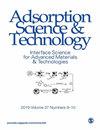氮掺杂碳点(NCDs)对NCD/MIL-53(Fe)复合材料特性及其在可见光下降解亚甲基蓝的光催化性能的影响
IF 2.8
4区 工程技术
Q2 CHEMISTRY, APPLIED
引用次数: 6
摘要
金属有机骨架复合材料是由金属有机骨架和先进的碳材料相结合而成,在环境修复和催化剂等许多应用领域引起了极大的关注。在本文中,通过原位合成制备了碳/MIL-53(Fe)复合材料,其中在经过溶剂热阶段之前,将含氮碳点(NCDs)与MOF前体的溶液以不同比例混合。结果表明,引入一定量的NCDs会影响最终产物的特性,提高其光催化性能。确定了NCD/MIL-53(Fe)复合材料中NCDs的最佳掺杂量。SEM图像显示,M-140呈六边形双锥状晶体,平均尺寸为700 nm。与原始的MIL-53(Fe)相比,M-140具有更明显的光响应性,其计算的带隙能量约为2.3 此外,M-140催化剂在5至7的pH范围内对亚甲基蓝的降解也表现出更优异的光催化活性。在最佳条件下,MB在60分钟内达到,5次循环后去除率接近100%。讨论了所制备的NCD/MIL-53(Fe)复合材料的光催化机理。本文章由计算机程序翻译,如有差异,请以英文原文为准。
Effect of Nitrogen-Doped Carbon Dots (NCDs) on the Characteristics of NCD/MIL-53(Fe) Composite and Its Photocatalytic Performance for Methylene Blue Degradation under Visible Light
Metal-organic framework composites, which are combined from metal-organic framework and advanced carbon material, have drawn great attention in many fields of application such as environmental remediation and catalysts. Within this paper, the carbon/MIL-53(Fe) composite was fabricated via an in situ synthesis, in which N-containing carbon dots (NCDs) were mixed with MOF precursors’ solutions under various ratios before going through the solvothermal stage. It was showed that the introduction of a certain amount of NCDs would affect characteristic features and improve the photocatalytic performance of final products. The optimal doping content of NCDs in NCD/MIL-53(Fe) composite was determined. SEM images showed that the M-140 appeared as hexagonal bipyramid-shaped crystals with an average size of 700 nm. Compared with pristine MIL-53(Fe), the M-140 was more visibly light-responsive, and its calculated band gap energy was approximately 2.3 eV. In addition, M-140 catalyst also displayed more excellent photocatalytic activity for Methylene Blue degradation in a pH range from 5 to 7. Under optimal conditions, MB was achieved within 60 minutes and the removal rate was nearly 100% after 5 cycles. The photocatalytic mechanism of the obtained NCD/MIL-53(Fe) composite was discussed.
求助全文
通过发布文献求助,成功后即可免费获取论文全文。
去求助
来源期刊

Adsorption Science & Technology
工程技术-工程:化工
CiteScore
5.00
自引率
10.30%
发文量
181
审稿时长
4.5 months
期刊介绍:
Adsorption Science & Technology is a peer-reviewed, open access journal devoted to studies of adsorption and desorption phenomena, which publishes original research papers and critical review articles, with occasional special issues relating to particular topics and symposia.
 求助内容:
求助内容: 应助结果提醒方式:
应助结果提醒方式:


